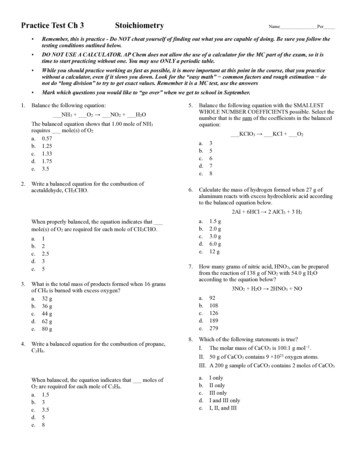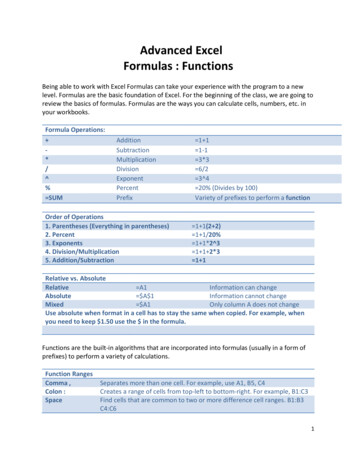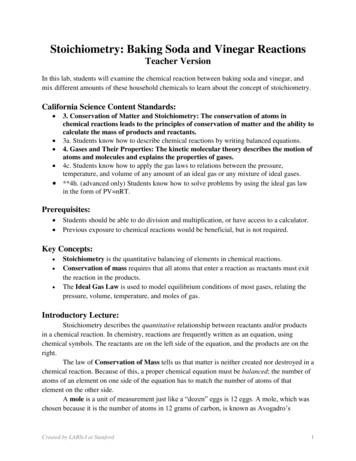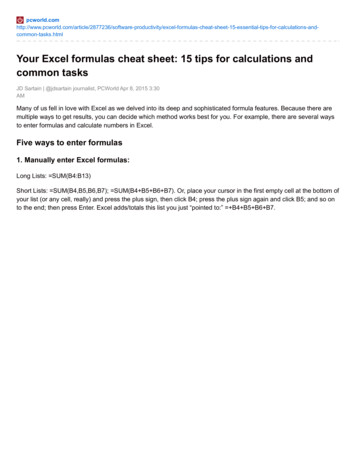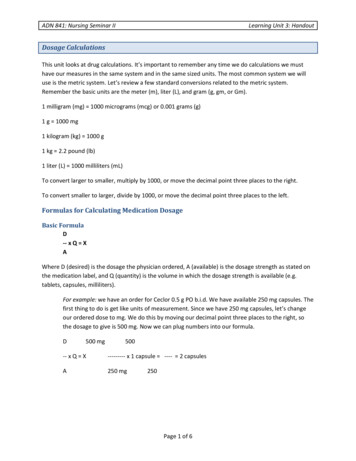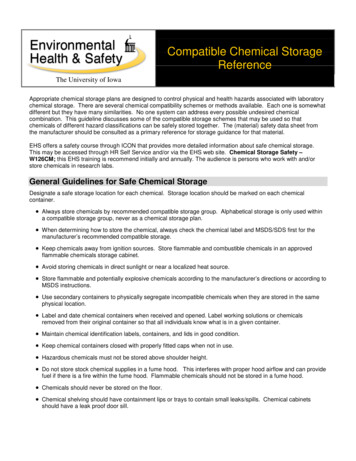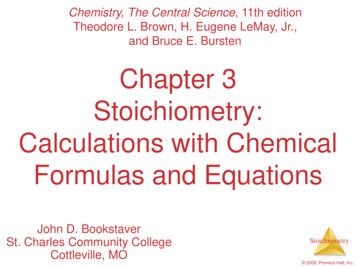
Transcription
Chemistry, The Central Science, 11th editionTheodore L. Brown, H. Eugene LeMay, Jr.,and Bruce E. BurstenChapter 3Stoichiometry:Calculations with ChemicalFormulas and EquationsJohn D. BookstaverSt. Charles Community CollegeCottleville, MOStoichiometry 2009, Prentice-Hall, Inc.
Law of Conservation of Mass“We may lay it down as anincontestable axiom that, in allthe operations of art and nature,nothing is created; an equalamount of matter exists bothbefore and after the experiment.Upon this principle, the whole artof performing chemicalexperiments depends.”--Antoine Lavoisier, 1789Stoichiometry 2009, Prentice-Hall, Inc.
Chemical EquationsChemical equations are conciserepresentations of chemical reactions.Stoichiometry 2009, Prentice-Hall, Inc.
Anatomy of a Chemical EquationCH4 (g) 2 O2 (g)CO2 (g) 2 H2O (g)Stoichiometry 2009, Prentice-Hall, Inc.
Anatomy of a Chemical EquationCH4 (g) 2 O2 (g)Reactants appear on the leftside of the equation.CO2 (g) 2 H2O (g)Stoichiometry 2009, Prentice-Hall, Inc.
Anatomy of a Chemical EquationCH4 (g) 2 O2 (g)Products appear on theright side of the equation.CO2 (g) 2 H2O (g)Stoichiometry 2009, Prentice-Hall, Inc.
Anatomy of a Chemical EquationCH4 (g) 2 O2 (g)CO2 (g) 2 H2O (g)The states of the reactants and productsare written in parentheses to the right ofeach compound.Stoichiometry 2009, Prentice-Hall, Inc.
Anatomy of a Chemical EquationCH4 (g) 2 O2 (g)Coefficients are insertedto balance the equation.CO2 (g) 2 H2O (g)Stoichiometry 2009, Prentice-Hall, Inc.
Subscripts and Coefficients GiveDifferent Information Subscripts tell the number of atoms ofeach element in a molecule.Stoichiometry 2009, Prentice-Hall, Inc.
Subscripts and Coefficients GiveDifferent Information Subscripts tell the number of atoms ofeach element in a molecule Coefficients tell the number ofmolecules.Stoichiometry 2009, Prentice-Hall, Inc.
ReactionTypesStoichiometry 2009, Prentice-Hall, Inc.
Combination Reactions In this type ofreaction twoor moresubstancesreact to formone product. Examples:– 2 Mg (s) O2 (g) 2 MgO (s)– N2 (g) 3 H2 (g) 2 NH3 (g)– C3H6 (g) Br2 (l) C3H6Br2 (l)Stoichiometry 2009, Prentice-Hall, Inc.
Decomposition Reactions In a decompositionone substance breaksdown into two or moresubstances. Examples:– CaCO3 (s) CaO (s) CO2 (g)– 2 KClO3 (s) 2 KCl (s) O2 (g)– 2 NaN3 (s) 2 Na (s) 3 N2 (g)Stoichiometry 2009, Prentice-Hall, Inc.
Combustion Reactions These are generallyrapid reactions thatproduce a flame. Most often involvehydrocarbonsreacting with oxygenin the air. Examples:– CH4 (g) 2 O2 (g) CO2 (g) 2 H2O (g)– C3H8 (g) 5 O2 (g) 3 CO2 (g) 4 H2O (g)Stoichiometry 2009, Prentice-Hall, Inc.
FormulaWeightsStoichiometry 2009, Prentice-Hall, Inc.
Formula Weight (FW) A formula weight is the sum of theatomic weights for the atoms in achemical formula. So, the formula weight of calciumchloride, CaCl2, would beCa: 1(40.1 amu) Cl: 2(35.5 amu)111.1 amu Formula weights are generally reportedfor ionic compounds.Stoichiometry 2009, Prentice-Hall, Inc.
Molecular Weight (MW) A molecular weight is the sum of theatomic weights of the atoms in amolecule. For the molecule ethane, C2H6, themolecular weight would beC: 2(12.0 amu) H: 6(1.0 amu)30.0 amuStoichiometry 2009, Prentice-Hall, Inc.
Percent CompositionOne can find the percentage of themass of a compound that comes fromeach of the elements in the compoundby using this equation:(number of atoms)(atomic weight)% element (FW of the compound)x 100Stoichiometry 2009, Prentice-Hall, Inc.
Percent CompositionSo the percentage of carbon in ethaneis (2)(12.0 amu)%C (30.0 amu)24.0 amux 100 30.0 amu 80.0%Stoichiometry 2009, Prentice-Hall, Inc.
MolesStoichiometry 2009, Prentice-Hall, Inc.
Avogadro’s Number 6.02 x 1023 1 mole of 12C has amass of 12 g.Stoichiometry 2009, Prentice-Hall, Inc.
Molar Mass By definition, a molar mass is the massof 1 mol of a substance (i.e., g/mol).– The molar mass of an element is the massnumber for the element that we find on theperiodic table.– The formula weight (in amu’s) will be thesame number as the molar mass (ing/mol).Stoichiometry 2009, Prentice-Hall, Inc.
Using MolesMoles provide a bridge from the molecularscale to the real-world scale.Stoichiometry 2009, Prentice-Hall, Inc.
Mole Relationships One mole of atoms, ions, or molecules containsAvogadro’s number of those particles. One mole of molecules or formula units containsAvogadro’s number times the number of atoms orions of each element in the compound.Stoichiometry 2009, Prentice-Hall, Inc.
FindingEmpiricalFormulasStoichiometry 2009, Prentice-Hall, Inc.
Calculating Empirical FormulasOne can calculate the empirical formula fromthe percent composition.Stoichiometry 2009, Prentice-Hall, Inc.
Calculating Empirical FormulasThe compound para-aminobenzoic acid (you may haveseen it listed as PABA on your bottle of sunscreen) iscomposed of carbon (61.31%), hydrogen (5.14%),nitrogen (10.21%), and oxygen (23.33%). Find theempirical formula of PABA.Stoichiometry 2009, Prentice-Hall, Inc.
Calculating Empirical FormulasAssuming 100.00 g of para-aminobenzoic acid,C:H:N:O:1 mol12.01 g1 mol5.14 g x1.01 g1 mol10.21 g x14.01 g1 mol23.33 g x16.00 g61.31 g x 5.105 mol C 5.09 mol H 0.7288 mol N 1.456 mol OStoichiometry 2009, Prentice-Hall, Inc.
Calculating Empirical FormulasCalculate the mole ratio by dividing by the smallest numberof moles:C:5.105 mol0.7288 mol 7.005 7H:5.09 mol0.7288 mol 6.984 7N:0.7288 mol0.7288 mol 1.000O:1.458 mol0.7288 mol 2.001 2Stoichiometry 2009, Prentice-Hall, Inc.
Calculating Empirical FormulasThese are the subscripts for the empirical formula:C7H7NO2Stoichiometry 2009, Prentice-Hall, Inc.
Combustion Analysis Compounds containing C, H and O are routinelyanalyzed through combustion in a chamber like this.– C is determined from the mass of CO2 produced.– H is determined from the mass of H2O produced.– O is determined by difference after the C and H have beendetermined.Stoichiometry 2009, Prentice-Hall, Inc.
Elemental AnalysesCompoundscontaining otherelements areanalyzed usingmethods analogousto those used for C,H and O.Stoichiometry 2009, Prentice-Hall, Inc.
Stoichiometric CalculationsThe coefficients in the balanced equation givethe ratio of moles of reactants and products.Stoichiometry 2009, Prentice-Hall, Inc.
Stoichiometric CalculationsStarting with themass of SubstanceA you can use theratio of thecoefficients of A andB to calculate themass of SubstanceB formed (if it’s aproduct) or used (ifit’s a reactant).Stoichiometry 2009, Prentice-Hall, Inc.
Stoichiometric CalculationsC6H12O6 6 O2 6 CO2 6 H2OStarting with 1.00 g of C6H12O6 we calculate the moles of C6H12O6 use the coefficients to find the moles of H2O and then turn the moles of water to grams.Stoichiometry 2009, Prentice-Hall, Inc.
LimitingReactantsStoichiometry 2009, Prentice-Hall, Inc.
How Many Cookies Can I Make? You can make cookiesuntil you run out of oneof the ingredients. Once this family runsout of sugar, they willstop making cookies(at least any cookiesyou would want to eat).Stoichiometry 2009, Prentice-Hall, Inc.
How Many Cookies Can I Make? In this example thesugar would be thelimiting reactant,because it will limit theamount of cookies youcan make.Stoichiometry 2009, Prentice-Hall, Inc.
Limiting Reactants The limiting reactant is the reactant present inthe smallest stoichiometric amount.– In other words, it’s the reactant you’ll run out of first (inthis case, the H2).Stoichiometry 2009, Prentice-Hall, Inc.
Limiting ReactantsIn the example below, the O2 would be theexcess reagent.Stoichiometry 2009, Prentice-Hall, Inc.
Theoretical Yield The theoretical yield is the maximumamount of product that can be made.– In other words it’s the amount of productpossible as calculated through thestoichiometry problem. This is different from the actual yield,which is the amount one actuallyproduces and measures.Stoichiometry 2009, Prentice-Hall, Inc.
Percent YieldOne finds the percent yield bycomparing the amount actually obtained(actual yield) to the amount it waspossible to make (theoretical yield).Actual YieldPercent Yield Theoretical Yieldx 100Stoichiometry 2009, Prentice-Hall, Inc.
How many oxygen atoms are presentin MgSO4 7 H2O? 4 oxygen atoms5 oxygen atoms7 oxygen atoms11 oxygen atoms18 oxygen atomsStoichiometry
How many oxygen atoms are presentin MgSO4 7 H2O? 4 oxygen atoms5 oxygen atoms7 oxygen atoms11 oxygen atoms18 oxygen atomsStoichiometry
How many sulfur atoms are presentin 1.0 mole of Al2(SO4)3? 1 sulfur atom3 sulfur atoms4 sulfur atoms6.0 x 1023 sulfur atoms1.8 x 1024 sulfur atomsStoichiometry
How many sulfur atoms are present in 1.0 mole of Al2(SO4)3?1 sulfur atom3 sulfur atoms4 sulfur atoms6.0 x 1023 sulfur atoms1.8 x 1024 sulfur atomsStoichiometry
If you have equal masses of the following metals,which will have the most number of atoms?1. lithium2. sodium3. potassium4. rubidium5. calciumAn alkali metalCa in H2OStoichiometry
If you have equal masses of the following metals,which will have the most number of atoms?1. lithium2. sodium3. potassium4. rubidium5. calciumAn alkali metalCa in H2OStoichiometry
How many moles of oxygen gas are requiredto react completely with 1.0 mole NO?2 NO (g) O2 (g)2 NO2 (g)1. 0.5 mol O22. 1.0 mol O23. 1.5 mol O24. 2.0 mol O25. 2.5 mol O2Stoichiometry
How many moles of oxygen gas are requiredto react completely with 1.0 mole NO?2 NO (g) O2 (g)2 NO2 (g)1. 0.5 mol O22. 1.0 mol O23. 1.5 mol O24. 2.0 mol O25. 2.5 mol O2Stoichiometry
If 10.0 moles of NO are reacted with 6.0 molesO2, how many moles NO2 are produced?2 NO (g) O2 (g)2 NO2 (g)1. 2.0 mol NO22. 6.0 mol NO23. 10.0 mol NO24. 16.0 mol NO25. 32.0 mol NO2Stoichiometry
If 10.0 moles of NO are reactedwith 6.0 moles O2, how manymolesNOareproduced?22 NO (g) O (g)2 NO (g)221. 2.0 mol NO22. 6.0 mol NO23. 10.0 mol NO24. 16.0 mol NO25. 32.0 mol NO2Stoichiometry
If 10.0 moles of CO are reacted with 6.0 moles O2,how many moles of the excess reagent remain?2 NO (g) O2 (g)2 NO2 (g)1. 1.0 mol O22. 5.0 mol O23. 4.0 mol NO4. 8.0 mol NO5. None of the aboveStoichiometry
If 10.0 moles of CO are reacted with 6.0 moles O2,how many moles of the excess reagent remain?2 NO (g) O2 (g)2 NO2 (g)1. 1.0 mol O22. 5.0 mol O23. 4.0 mol NO4. 8.0 mol NO5. None of the aboveStoichiometry
In a chemical equation, thesubstances to the left of thearrow are called .Stoichiometry
In a chemical equation, thesubstances to the left of thearrow are called .Stoichiometry
When hydrocarbons areburned in air, they form:a.b.c.d.water and carbon dioxide.charcoal.methane.oxygen and water.Stoichiometry
When hydrocarbons areburned in air, they form:a.b.c.d.water and carbon dioxide.charcoal.methane.oxygen and water.Stoichiometry
The formula weight ofNa3PO4 is:a.b.c.d.70 grams/mole164 grams/mole265 grams/mole116 grams/moleStoichiometry
The formula weight ofNa3PO4 is:a.b.c.d.70 grams/mole164 grams/mole265 grams/mole116 grams/moleStoichiometry
The percentage by mass ofphosphorus in Na3PO4 is:a.b.c.d.44.0%11.7%26.7%18.9%Stoichiometry
The percentage by mass ofphosphorus in Na3PO4 is:a.b.c.d.44.0%11.7%26.7%18.9%Stoichiometry
The formula weight of anysubstance is equal to:a.b.c.d.Avogadro’s number.its atomic weight.its density.its molar mass.Stoichiometry
The formula weight of anysubstance is equal to:a.b.c.d.Avogadro’s number.its atomic weight.its density.its molar mass.Stoichiometry
Ethyl alcohol contains 52.2% C,13.0% H, and 34.8 % O by mass.What is the empirical formula ofethyl alcohol?a.b.c.d.C2H5O2C 2H 6OC 2H 6O 2C 3H 4O 2Stoichiometry
Ethyl alcohol contains 52.2% C,13.0% H, and 34.8 % O by mass.What is the empirical formula ofethyl alcohol?a.b.c.d.C2H5O2C 2H 6OC 2H 6O 2C 3H 4O 2Stoichiometry
Methyl methacrylate has a molarmass of 100 g/mole. When asample of methyl methacrylateweighing 3.14 mg was completelycombusted, the only productsformed were 6.91 mg of CO2 and2.26 mg of water. What is methylmethacrylate’s molecular formula?a. C7H16c. C5H8O2b. C6H12Od. C4H4O3Stoichiometry
Methyl methacrylate has a molarmass of 100 g/mole. When asample of methyl methacrylateweighing 3.14 mg was completelycombusted, the only productsformed were 6.91 mg of CO2 and2.26 mg of water. What is methylmethacrylate’s molecular formula?a. C7H16c. C5H8O2b. C6H12Od. C4H4O3Stoichiometry
2 Fe 3 Cl2 2 FeCl3If 10.0 grams of iron and 20.0grams of chlorine react as shown,what is the theoretical yield of ferricchloride?a.b.c.d.10.0 grams20.0 grams29.0 grams30.0 gramsStoichiometry
2 Fe 3 Cl2 2 FeCl3If 10.0 grams of iron and 20.0grams of chlorine react as shown,what is the theoretical yield of ferricchloride?a.b.c.d.10.0 grams20.0 grams29.0 grams30.0 gramsStoichiometry
C3H4O4 2 C2H6O C7H12O4 2 H2OWhen 15.0 grams of each reactantwere mixed together, the yield ofC7H12O4 was 15.0 grams. Whatwas the percentage yield?a.b.c.d.100.0%75.0%65.0%50.0%Stoichiometry
C3H4O4 2 C2H6O C7H12O4 2 H2OWhen 15.0 grams of each reactantwere mixed together, the yield ofC7H12O4 was 15.0 grams. Whatwas the percentage yield?a.b.c.d.100.0%75.0%65.0%50.0%Stoichiometry
The percentage yield of areaction is (100.0%)(X). Whichof the following is X?a.b.c.d.theoretical yield / actual yieldcalculated yield / actual yieldcalculated yield / theoretical yieldactual yield / theoretical yieldStoichiometry
The percentage yield of areaction is (100.0%)(X). Whichof the following is X?a.b.c.d.theoretical yield / actual yieldcalculated yield / actual yieldcalculated yield / theoretical yieldactual yield / theoretical yieldStoichiometry
Stoichiometric Calculations Starting with 1.00 g of C 6 H 12 O 6 we calculate the moles of C 6 H 12 O 6 use the coefficients to find the moles of H 2O and then turn the moles



